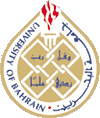University of Bahrain
The University of Bahrain (Arabic: جامعة البحرين , informally Bahrain University, abbreviated as UOB) is the largest public university in the Kingdom of Bahrain. It is the only national university in the country. With campuses in Sakhir, Isa Town and Manama, the university has more than 20,000 registered students and over 2000 staff members.[1]
جامعة البحرين Ǧāmaʿat al-Baḥrayn | |
 UOB Logo | |
| Motto | وَقُل رَّبِّ زِدْنِي عِلْماً |
|---|---|
Motto in English | "Say: My God! Increase my knowledge." |
| Type | Public |
| Established | 1986 |
| Endowment | BD 43 million[1] |
| President | Prof Riyad Y Hamzah |
Academic staff | 880 |
Administrative staff | 2,082 |
| Students | 30,317 |
| Location | Zallaq, Southern Governorate, Bahrain |
| Campus | Sakhir and Isa Town 156,607 m2 (1,685,700 sq ft) |
| Affiliations | FUIW |
| Website | www |
The university is a member of the International Association of Universities and the Islamic Educational, Scientific and Cultural Organization.[1]
History
The University of Bahrain was established in 1986 as a result of Amiri Decree No. 12 /1986. The decree resulted in the merger of two public colleges; the Gulf Polytechnic (previously established in 1968) and the University College of Arts, Science and Education (established in 1979).[2]
Campus

The university has three campuses. Its main campus in Sakhir covers an area of 103657m2 and houses all the colleges except the Colleges of Health Science and Engineering. The College of Health Sciences is based in a 10,000 m2 (110,000 sq ft) campus next to the Salmaniya Medical Complex. The College of Engineering is based in a 10,000 m2 (110,000 sq ft) campus alongside the Bahrain Polytechnic.[1]
The university owns a total of 66 buildings, 240 classrooms, 183 labs, and three gymnasiums.[1] The university has four libraries, with the Central Library having an estimated 250,000 books in stock. The library also has access to the British Library database.[3]
Colleges
The University of Bahrain receives US$110 million as a budget from the Bahraini government. The university itself consists of 10 constituent colleges:[1]
- S1A - College of Arts
- S1B - College of Business Administration
- S20B & S20C - College of Applied Studies
- S20A - College of Physical Education & Physiotherapy
- S22 - Bahrain Teachers College (BTC)
- S39 - College of Law
- S40 - College of Information Technology
- S41 - College of Science
- College of Engineering (Isa Town)
- College of Health Sciences
Other buildings
Aside from colleges; the university includes other buildings around the main Sakhir campus for different purposes:
- S37 - Admission & Registration
- S17 - The Department of English Language and Literature & the Students Council Center
- I14 - Engineering
- I15 - Engineering
- S18 - Exams Hall
- S20 - The English Language Center
- S47 - The IT & Science Library
- Swimming Pool (Physical Education)
- The Bahrain Credit Media Center
- Zain E-Learning Center
- The Confucius Institute for Chinese Language Courses
- The King Sejong Institute for Korean Language Courses
- Student & Teachers' Apartments
- Gulf University Society Center
- Printing Center
Academia

The university offers more than 102 academic programs, including 42 Bachelor programs, 39 Master's degrees, 10 PhDs and 11 associate diplomas. Credit hours vary between courses and degree level (126-135 credit hours for bachelor's degrees, for example). [4] The university admits 15,000 students per annum, 80% of whom start in September.[1] The university's admission criteria generally require a high school score of 70%, in addition to other criteria imposed by some colleges.[4]
Research
Since 1986, more than 5,000 research papers and books were published by academics in the university, 80% of which was produced by the Colleges of Science and Engineering respectively. The university allocates US$11 million annually towards research and supports 38 full-time research personnel. More than 500 Masters thesis was published since the university's inception.[1]
Reputation
The university consistently ranks as the first nationally, 23rd amongst Arab universities and 801-1000 internationally according to QS World University Rankings as of 2020.[1]
Student life
The university has 30,317 registered students at the start of the 2014/15 academic year, more than 65% of whom are female. 10.5% of the student population are international students. There were an estimated 700 events and activities in the 2012–13 academic year.[1] The university has a student council elected annually, with each constituent college electing a representative.[5]
Notable alumni
- Salman Bin Ibrahim Al-Khalifa, President of the Asian Football Confederation
- Mohamed Ali Hasan Ali, Member of the Consultative Council
References
- "Fast Facts". About UOB. University of Bahrain. Archived from the original on 1 July 2015. Retrieved 30 June 2015.
- Peck 2007, p. 86.
- QAAET 2010, p. 28.
- QAAET 2010, p. 6.
- "UOB organizes 9th Student Council". University of Bahrain. Archived from the original on 1 July 2015. Retrieved 30 June 2015.
- Bibliography
- Peck, Malcolm C. (2007). Historical Dictionary of the Gulf Arab States (2. ed.). Lanham: Rowman & Littlefield Pub. Group. ISBN 9780810864160.CS1 maint: ref=harv (link)
- QAAET (2010). Institutional Review Report: University of Bahrain (PDF) (Report). Higher Education Review Unit. Retrieved 30 June 2015.CS1 maint: ref=harv (link)